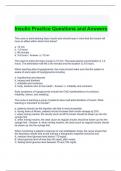Week 1
Wohlwill, J. F. (1970). The emerging discipline of environmental psychology. American Psychologist,
25 , 303-312.
Three forms of the interrelationship between behavior and environment
- Behavior necessarily occurs in some particular environmental context and behavior (particularly
movement) occurs within a given type of space.
- Certain qualities of the environment (e.g., under- or overstimulation, crowding, severity of climate,
etc.), may exert generalized effects on broader systems of response within the individual.
- Behavior is in a variety of ways instigated by and directed at particular attributes and characteristics
of the physical environment.
Proxemics: the use of space in everyday behavior.
Motivational force of environmental stimulation
1. Affect evoked by stimulus characteristics (e.g., complexity, diversity, novelty, category)
2. Environment determines approach and avoidance reactions (moving, migrating, holiday
destinations).
3. Adaption (‘’man is at once a seeker and neutralizer of stimulation’’). People seek for an optimal
level of stimulation, but also people get used to the stimulation so they get bored. Environment can
help: if you like hiking, you start with a small hill, but in the long-term you seek for more steeper hills.
Challenge for psychology
Four primary forms that our involvement in this area can take:
1. Research, both basic and applied.
2. Training of and consultation with prospective and actual workers in professions dealing with
environmental problems.
3. Graduate training for psychologists.
4. The undergraduate psychology curriculum.
Goldberg, T. (1969). The automobile. A social institution for adolescents. Environment and Behavior,
1 , 152-185.
Problem description: adolescents have nowhere to go, they like cars → they take the road for social
gathering (‘’cruising’’). Their problem solving creates problems for others: blocking of roads, creating
unsafety, noise annoyance.
Why is this happening and what does this phenomenon look like?
He found that there are important aspects for these youngsters: peer group influences, sexual
activity and rivalry (climb up in your group, more status). The meeting place where all these aspects
are combined should be a ‘’full blown social arena’’. Adolescents love cars and cars are suitable for
competition and have sexual symbolism.
Observations: cruising has strict codes
Men often drive alone, aspire to have expensively altered hot cars, are to be found in places best
suited for display and have windows rolled down.
Women drive not alone, when they are in pairs they are open to a date and have windows often
, closed.
Outcomes: all the activities that youngster did, took place in or nearby the car (so the car is really
important for their activities). The cruisers maximize visibility (by driving around streets or parking),
while those who park position themselves to get clearest visibility of the strip activity. Cruising is self-
sustaining, no need for other amusement facilities (just needs road, parking places and good lights to
be seen).
Kaplan, S. (1995). The restorative benefits of nature: Toward an integrative framework. Journal of
Environmental Psychology, 15, 169-182.
Introduction
Attention Restoration Theory: people can concentrate better after spending time in nature, or even
looking at scenes of nature.
Nature and the Restorative Environment
What makes an environment restorative:
(1) Being away, at least in principle, frees one from mental activity that requires directed attention
support to keep going. The seaside, the mountains, lakes, streams, forests, and meadows are all
idyllic places for ‘getting away’.
(2) Fascination. Nature is certainly well-endowed with fascinating objects, as well as offering many
processes that people find engrossing. Many of the fascinations afforded by the natural setting
qualify as ‘soft’ fascinations: clouds, sunsets, snow patterns, the motion of the leaves in the breeze.
(2) The environment must have extent. It must be rich enough and coherent enough so that it
constitutes a whole other world. It must provide enough to see, experience, and think about so that
it takes up a substantial portion of the available room in one’s head.
(3) There should be compatibility between the environment and one’s purposes and inclinations.
The setting must fit what one is trying to do and what one would like to do.
Different studies show that there is a link between restorative experiences and information-
processing effectiveness/directed attention. The majority of these findings were obtained without
corresponding influences on mood. Since mood enhancement is a frequent goal of stress reduction
procedures (presumably to reduce the aversiveness of the stress inducing situation), this finding is
suggestive of a distinctive effect of restorative experiences on directed attention.
Toward an Integration
Stress → attentional decline
Stress response: an organism’s adaptive mobilization to deal with a potentially negative situation.
Factors leading to this adaptive mobilization:
- Harm: certain patterns, like something suddenly looming in one’s face, automatically indicate the
threat of impending harm.
- Resource inadequacy: focuses on whether one has the resources necessary to deal with the
situation one is facing (or anticipates facing at some point in the future).
* 1 - appraisal: the individual determines that the available resources are insufficient.
* 2 - ‘intuition’ or even ‘pre-attentive process’: involves information processing but of a variety so
much faster and so unlikely to be conscious that the term ‘appraisal’ would not be an appropriate
description.








